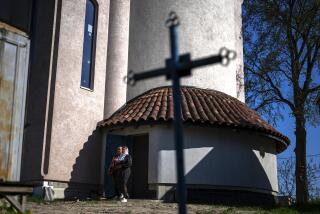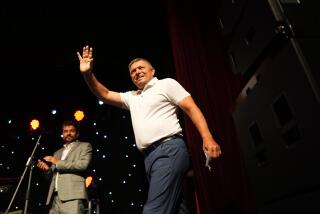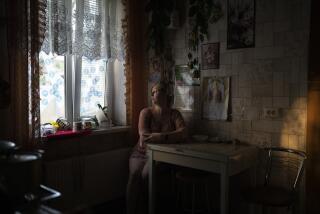One Village Lies in Two Countries, Two Worlds
SOLONCI, Ukraine — The brother and sister live in the same village and on the same street. Yet they are a world apart.
Maria and Arpad Ivan have been able to hug each other only twice in the last 53 years--their fractured relationship a victim of decades of East-West mistrust that lingers starkly at the Slovakia-Ukraine border.
Even though their nations were Soviet bloc allies, nearly a decade after the Iron Curtain was lifted and the Berlin Wall fell the Ivans and their neighbors are still divided by barbed wire and red tape.
A post-World War II treaty drew the border down the middle of the village, cruelly separating families and friends. For those still alive from that chilling time, the hope of undoing it in their lifetimes is fast dying.
“If only I could see my brother once again,” 85-year-old Maria Ivan Jevcsak says, looking westward from her dilapidated home on the Ukrainian side toward her brother’s home, where he is confined by ill health.
“We’re both old and frail--who knows how long we’ll live?--and the barbed wire that separates us seems eternal,” she adds, sobbing.
Crossing the border elsewhere is possible. But the costly, arduous overnight journey--which involves buying passports and waiting all day at a border crossing more than 30 miles away just to cross the street--is out of the question for the poor, aging Ivans and others.
The village is 12 miles north of where the borders of Ukraine, Slovakia and Hungary meet, and its long list of nationality switches reflects a turbulent history.
About half the 1,100 villagers live on the Ukrainian side, which is called Solonci, and half are in the Slovak part, known as Velke Slemence. Almost all of them are ethnic Hungarians, but their village has been passed around among six countries this century.
When Maria was born in 1913, the village was named Szelmenc and was part of the Austro-Hungarian Empire. It was given to Czechoslovakia after World War I, then reverted to Hungary in 1938. Her half was put in the Soviet Union after World War II and has been part of Ukraine since the Soviet breakup in 1991.
The other half of the village reverted to Czechoslovakia after the war, then became Slovak when that nation split five years ago.
When the control-obsessed Soviets erected the barbed-wire fence in 1945, residents at first were allowed to pass freely between the two sides to see relatives, harvest crops, go to church.
Then one chilling day the border was sealed, even though both sides were in allied communist states.
Whoever got stuck on the wrong side was stuck for a lifetime. One little girl who had the flu was staying with her grandmother on the Slovak side while her mother and father were working in the fields in Ukraine. Her parents never saw her again.
When Maria’s mother died on the Slovak side, she and her husband were denied a permit to attend the funeral. They stood at the barbed wire with their flowers, listening to the priest’s prayers and family members’ sobs from the cemetery just 200 yards away.
A crossing was opened on two occasions during Mikhail Gorbachev’s time as Soviet leader. But authorities of the independent Ukraine are tougher than ever, maintaining border patrols and even forbidding conversations across the border fence.
The guards keep a high vigilance “to implement earlier agreements by politicians,” said Serhiy Astakhov, a border guard spokesman in Kiev, Ukraine’s capital.
Divided for decades, the two sides of the village have grown into different worlds.
On the Slovak side, store shelves are full of goods. On the Ukrainian side, even staple items like bread and milk are in short supply.
Family ties have loosened. The old generation is almost all gone, and the young have grown up not knowing anything different.
But the heartache continues for the Ivans and a few others.
Since her brother is too frail to come outside, Maria used a visit by foreigners to arrange a rare border meeting recently with her sister-in-law, Terezia, 60, from the Slovak side.
The two women stood 25 feet apart and shouted across the tall barbed-wire barrier.
“How are you?” Maria asked, looking around warily.
In the past, she says, when people were caught chatting, “they took them away, and some have never returned.”
Sending letters is unreliable. The village seems officially forgotten on both sides--neither Solonci nor Velke Slemence appears on maps.
Most of the time those on the Slovak side have their letters to the other part of the village returned, stamped “Address unknown.”
More to Read
Sign up for Essential California
The most important California stories and recommendations in your inbox every morning.
You may occasionally receive promotional content from the Los Angeles Times.










